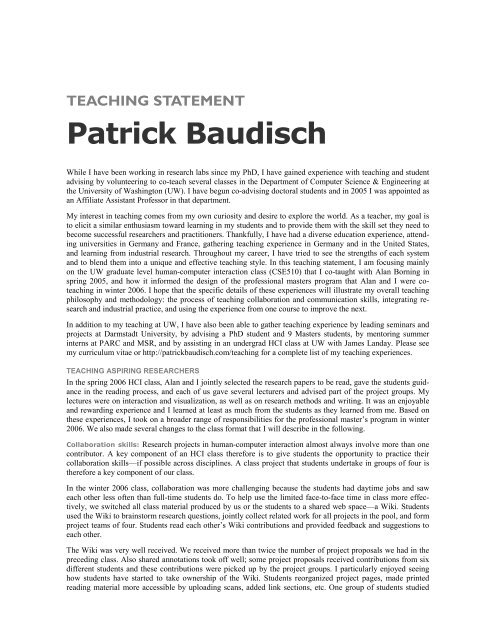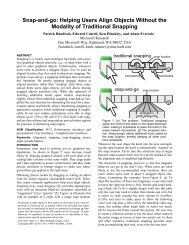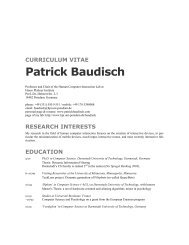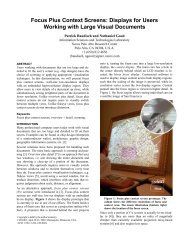PDF (3 pages) - Patrick Baudisch
PDF (3 pages) - Patrick Baudisch
PDF (3 pages) - Patrick Baudisch
You also want an ePaper? Increase the reach of your titles
YUMPU automatically turns print PDFs into web optimized ePapers that Google loves.
TEACHING STATEMENT<br />
<strong>Patrick</strong> <strong>Baudisch</strong><br />
While I have been working in research labs since my PhD, I have gained experience with teaching and student<br />
advising by volunteering to co-teach several classes in the Department of Computer Science & Engineering at<br />
the University of Washington (UW). I have begun co-advising doctoral students and in 2005 I was appointed as<br />
an Affiliate Assistant Professor in that department.<br />
My interest in teaching comes from my own curiosity and desire to explore the world. As a teacher, my goal is<br />
to elicit a similar enthusiasm toward learning in my students and to provide them with the skill set they need to<br />
become successful researchers and practitioners. Thankfully, I have had a diverse education experience, attending<br />
universities in Germany and France, gathering teaching experience in Germany and in the United States,<br />
and learning from industrial research. Throughout my career, I have tried to see the strengths of each system<br />
and to blend them into a unique and effective teaching style. In this teaching statement, I am focusing mainly<br />
on the UW graduate level human-computer interaction class (CSE510) that I co-taught with Alan Borning in<br />
spring 2005, and how it informed the design of the professional masters program that Alan and I were coteaching<br />
in winter 2006. I hope that the specific details of these experiences will illustrate my overall teaching<br />
philosophy and methodology: the process of teaching collaboration and communication skills, integrating research<br />
and industrial practice, and using the experience from one course to improve the next.<br />
In addition to my teaching at UW, I have also been able to gather teaching experience by leading seminars and<br />
projects at Darmstadt University, by advising a PhD student and 9 Masters students, by mentoring summer<br />
interns at PARC and MSR, and by assisting in an undergrad HCI class at UW with James Landay. Please see<br />
my curriculum vitae or http://patrickbaudisch.com/teaching for a complete list of my teaching experiences.<br />
TEACHING ASPIRING RESEARCHERS<br />
In the spring 2006 HCI class, Alan and I jointly selected the research papers to be read, gave the students guidance<br />
in the reading process, and each of us gave several lecturers and advised part of the project groups. My<br />
lectures were on interaction and visualization, as well as on research methods and writing. It was an enjoyable<br />
and rewarding experience and I learned at least as much from the students as they learned from me. Based on<br />
these experiences, I took on a broader range of responsibilities for the professional master’s program in winter<br />
2006. We also made several changes to the class format that I will describe in the following.<br />
Collaboration skills: Research projects in human-computer interaction almost always involve more than one<br />
contributor. A key component of an HCI class therefore is to give students the opportunity to practice their<br />
collaboration skills—if possible across disciplines. A class project that students undertake in groups of four is<br />
therefore a key component of our class.<br />
In the winter 2006 class, collaboration was more challenging because the students had daytime jobs and saw<br />
each other less often than full-time students do. To help use the limited face-to-face time in class more effectively,<br />
we switched all class material produced by us or the students to a shared web space—a Wiki. Students<br />
used the Wiki to brainstorm research questions, jointly collect related work for all projects in the pool, and form<br />
project teams of four. Students read each other’s Wiki contributions and provided feedback and suggestions to<br />
each other.<br />
The Wiki was very well received. We received more than twice the number of project proposals we had in the<br />
preceding class. Also shared annotations took off well; some project proposals received contributions from six<br />
different students and these contributions were picked up by the project groups. I particularly enjoyed seeing<br />
how students have started to take ownership of the Wiki. Students reorganized project <strong>pages</strong>, made printed<br />
reading material more accessible by uploading scans, added link sections, etc. One group of students studied
and experimentally evaluated Wiki usage in the classroom as their class project which helped us maximize our<br />
learning experience and to pinpoint the benefits and pitfalls of wikis.<br />
Communication skills: Another<br />
component I consider<br />
important is the ability to present<br />
work in written or oral<br />
form. In our class, students<br />
wrote 500-1000 word essays<br />
for each of the four homework<br />
assignments, as well as one<br />
longer project report. Since<br />
each student wrote about a<br />
different topic we could once<br />
more leverage the shared work<br />
space; it allowed students to<br />
see how their fellow students<br />
Student Meredith Skeels presents her project in the class Advanced Topics in Human-<br />
Computer Interaction (University of Washington, Spring’05, used with permission)<br />
approached the problem. To assure that student could practice their oral presentation skills, we included an<br />
additional midterm project presentation.<br />
When I advised students about their projects, my primary goal was to inspire them to come up with good research<br />
questions. In my experience, the large amount of technical training students receive throughout college<br />
can lead them to focus too much on the question of what can be done. While implementation is a highly relevant<br />
skill, becoming a successful researcher requires going beyond what has been done. Brainstorming skills<br />
and ‘deferred judgment’ in particular are keys for coming up with ideas that go beyond the constraints technology<br />
is facing today. In addition to mentoring students in class, I started mentoring UW Ph.D. student Susumu<br />
Harada in his work on the vocal joystick project, including meetings on a biweekly schedule. He was a member<br />
of the spring 2005 HCI class.<br />
BRINGING EXPERIENCE FROM INDUSTRY INTO THE CLASSROOM<br />
Teaching human-computer interaction not only involves teaching research skills, but also teaching the skills<br />
required to be a practitioner. My work at Microsoft Research has allowed me to work with a wide range of<br />
practitioners, such as usability engineers. Taking these experiences into account, we made changes to some of<br />
the homework assignments we used in class. The first assignment, for example, was inspired by Don Norman’s<br />
“Design of Everyday Things”. The initial version of this assignment, as we had used it in the preceding class<br />
required students to find a hard-to-use object and describe what was broken about it. Although the lab had gone<br />
well and students had come up with good examples, I felt that we were missing part of the objective. What<br />
seems to separate successful usability workers in industry from less successful ones is the ability to understand<br />
the tradeoffs involved in the given design and the ability to “pick their battles”. We revised the lab exercise by<br />
adding the following questions: What might have been the constraints and tradeoffs that motivated the decisions<br />
behind this design (e.g., cost cutting, graphics design, or marketing)? Can this usability problem be fixed<br />
or would the attempt make things worse? Which people would one need to get involved to fix the problem?<br />
Etc. Taking these tradeoffs into account will help students who choose to work in industry maximize their impact<br />
and minimize friction with other team members.<br />
Another noteworthy update is that we modified the structure of the class project, such that we required students<br />
to perform at least two design-prototype-evaluation iteration cycles. To make sure students had the skills required<br />
for the process, we provided them with an introduction to collecting user requirements, brainstorming<br />
designs, paper prototyping, and user testing. I also taught a class on prototyping in Macromedia Flash.<br />
BEYOND THE CLASSROOM<br />
In-classroom teaching can go a long way, but there are limits. Internships are a wonderful opportunity for students<br />
to learn about the realities in the “real world”. They allow students to try out their skills and acquire the<br />
experiences they need to succeed at whatever career path they choose. In the past, I have been able to see the<br />
industry side of this, while mentoring summer interns at PARC and MSR. In academia, I plan to leverage my<br />
industry connections to place students in internships at top-tier companies and research labs.
While I am in industry, I use my two hats as a Research Scientist at Microsoft Research and as an Affiliate<br />
Assistant Professor at UW to get students interested in both worlds. Last year, I brought the “dub” group (special<br />
interest group in HCI at UW, 35 students and faculty) to MSR. Students saw demos and presentations of<br />
about 10 different projects and had the chance to exchange thoughts with MSR researchers.<br />
My latest teaching experience was a class on the Design of Input Devices in the Industrial Design Department<br />
at the University of Washington (with Assistant Prof. Ahn Sang-gyeun). For their final presentations, I brought<br />
the students over to Microsoft Research for a 90min design critique with MSR researchers and members of<br />
product teams. I continue to work with these students to help them participate in design competitions and research<br />
publications.<br />
Students Zac Krane, Scott Tsukamaki, and Shayna Esteban present first drafts of their input device concepts in the class<br />
ART 316 Design for Industry (University of Washington, Fall’06, used with permission)<br />
In summary, as I continue to develop my teaching philosophy and methodology I have found key principles<br />
to include: teaching collaboration and communication skills, teaching students to ask interesting research questions,<br />
teaching students to see problems from an academic and an industrial point of view, and raising comprehension<br />
by involving students hands-on. My next teaching plans include designing and teaching a more specialized<br />
visualization and interaction class in the UW CS department.<br />
CLASSES I WOULD ENJOY TEACHING<br />
I would like to help develop and maintain a well-rounded curriculum in the field of human computer interaction,<br />
from introductory classes to advanced seminars. I think this curriculum should emphasize the multidisciplinary<br />
nature of the field and should offer tracks well suited for both future practitioners and research-minded<br />
students. In particular, I would enjoy teaching the following courses:<br />
• Introduction to Human Computer Interaction (undergrad): This introductory class would cover the<br />
characteristics of human and computer systems, major models for user interaction, task analysis and evaluation<br />
techniques, as well as rapid prototyping techniques and tools. It would include a small project so that<br />
students can get their first hands-on experience in the field.<br />
• Introduction to interaction design (undergrad): As a follow-up to the introductory course, this class<br />
would focus on techniques. At the core of the course would be a significant design project, which would<br />
cover the basic steps of interface design.<br />
• Visualization: from perception to understanding (grad): Starting from the basic principles of human<br />
perception, this research seminar would explore how to develop more effective visualization techniques.<br />
• Designing for small screens and mobile devices (grad): Visualization techniques for small screens;<br />
mobile applications, sensors, location, and ubiquitous computing, pen input, social mobile applications, interaction<br />
with mobile devices.<br />
Besides these core classes, I am comfortable teaching classes in Information Retrieval/Information Ubicomp,<br />
Filtering, Databases, Graphics, as well as undergraduate classes on general CS topics, such as programming<br />
languages and data structures.






